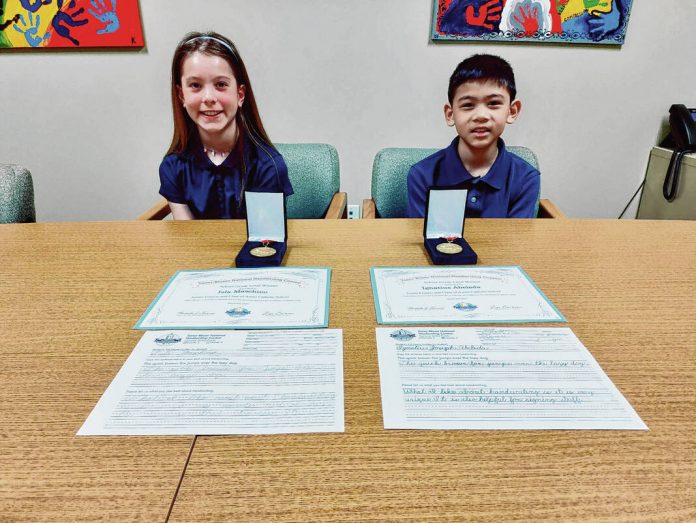Two students at Saints Francis & Clare of Assisi School were judged to have the best handwriting of any Indiana student in their grade level.
Third grader Isla Maschino and fourth grader Ignatius Abeleda represented their respective grades in the Zaner-Bloser National Handwriting Contest, which was open to students in kindergarten through eighth grade. To qualify, they wrote “The quick brown fox jumps over the lazy dog” in the best cursive they could produce, displaying their penmanship with a sentence that uses every letter of the alphabet.
Despite not being among the 18 students announced as National Grade-Level Semifinalists and Grand National Champions May 1, they were among just nine students from Indiana and the only ones from Johnson County to represent the Hoosier State, according to information from Zaner-Bloser, a Columbus, Ohio-based handwriting, reading, writing, spelling and vocabulary program producer that runs the contest.
Students were judged for the shape, size, spacing and slant of their letters. Of about 80,000 school-level participants and 2,716 competition entrants, they were among fewer than 450 students to advance to the national competition, according to information from the company’s website.
School staff members picked Maschino and Abeleda among the about 80 students who competed in the school’s contest earlier this year, after which representatives from Zaner-Bloser chose them among students from across the state. Even though some people may view penmanship as obsolete with the proliferation of technology, it’s key for students’ cognitive development, said Stephanie Cheesman, a retiree who volunteers as a handwriting teacher part-time at the school.
“Students who can both read and write in cursive tend to do better on classroom assessments and standardized testing,” Cheesman said. “It’s a tribute to the administration. They give kids exposure to handwriting as well as keyboarding once a week.”
Learning cursive improves retention and comprehension, enhances fine motor skills and helps students understand how words work together, according to the National Education Association.
Abeleda said he hopes his knowledge of cursive will pay dividends if he ever becomes famous.
“We started cursive and it was cool so I just wanted to do it and keep practicing and somehow, I got good at it,” he said. “It just looks cool and it’s unique. You can sign stuff if you’re famous because you’re learning how to write your autograph.”
Maschino said she enjoys writing in cursive because of its fancy look.
“Ever since I was in second grade, I’ve been learning cursive. It made me super happy because I love fancy writing and love to write it myself,” she said. “I think the most useful part of it is it can turn into words and words can turn into stories and I love stories.”
Advancing to the national competition increased her self-confidence, Maschino said.
“It makes me feel like I’m really good and have a really good talent and can do anything if I believe in myself,” she said.





